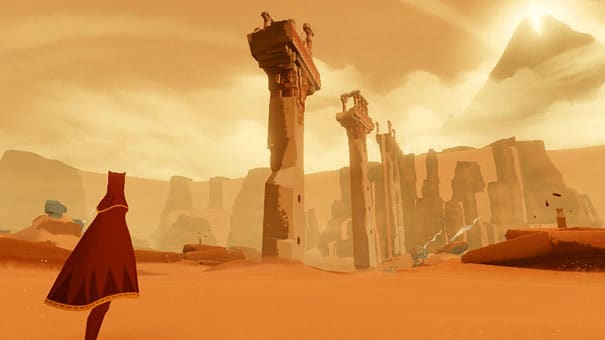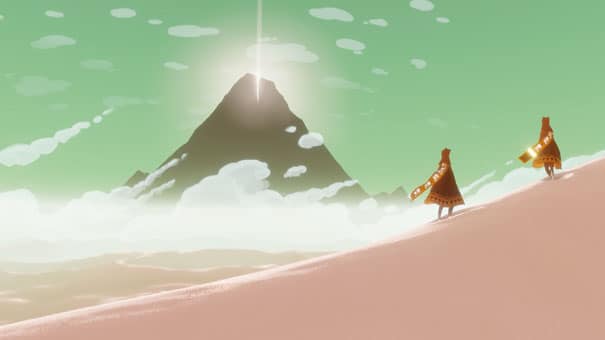There is swelling momentum behind the notion of video games being art. Sure, like movies, video games entertain with crowd pleasing commercialism and a burgeoning stable of sequels. However, just as for every nth version of Transformers and Die Hard, there is a The Fountain and Perfume, so with video games, we occasionally come across games that channel creative expression and ideas focused on leaving players with a sense of wonder, having been through an experience that is far removed from the ordinary, surreal even. Joining the ranks of creative showpieces like Child of Eden, Flower and Braid, we go on a trip with Journey.

The game is as concise and pointed as its title. Clocking in at about 90 minutes of playtime, Journey makes full use of those precious seconds to remove you as far away from the real world as it can, and into a sandy, icy wasteland of a ruined civilization, where your sole objective is to reach the summit of a mountain lit up by a white light. There is a complete lack of build up or back story at the outset, rendering the premise as basic as they come. You control a robed, armless figure whose motions are limited to running, shouting and, with the right ingredients, a floating jump. There are no voices, no dialogs, no text; just you and the desolate world… and an occasional companion.
The companions are an intriguing aspect of the game. Think of it as a co-op feature, except that you have no control over whom you play with. There are no lobbies, no party chat, no invites. You have the option to enable online mode at the start of the game and what this essentially does is allow two people to share the journey at random spots in the course of a playthrough. It is an evocative feature that transforms the experience. You cannot speak to your companion, so communication is limited to shouts and movement. Playing with a companion brings a powerful benefit to the experience, details of which will be kept off this review so as to not dilute the discovery. The feature is also unique in that you may start the game alone, meet up with a companion partway through the journey, lose sight of them and continue alone and meet up with a completely different companion later on. It is unusual to meet with eight or more different companions at various points in a single playthrough, although you will never see more than one companion on screen at any point in time.

The game takes you through three distinct areas in your quest to reach the mountaintop. You will use the power of your shout to reanimate ribbons throughout the game that provide you with the power of extended levitation. The ribbons are the true star of the game, waving, weaving, floating, connecting and uplifting the character. The path you forge through and with the ribbons yields a certain whimsical tone to the experience that is nearly identical to that witnessed in Flower, the developer’s previous effort. It is this mechanic that is chiefly responsible for the surreal character of the game and what makes Journey so special. There are a few sequences that have you traversing areas in different fashions that will provoke childlike glee, regardless of age, occupation or marital status. The final act of the game has the potential to create an actual reaction in you depending on how emotionally invested you become in the journey. It is a special, potent end to an experience that is rare in gaming.
The visuals play a large role in absorbing you into the world of Journey. The art is quite restrained, bordering on spartan, but what is there has been created with love, and it shows. Rippling sand, the wavy flow of the ribbons and the lighting are breathtaking. Certain levels have been built specifically to show off the technical and artistic wizardry of one or a combination of these elements with excellent results for the eyes, brain and heart. The sound is suitably sparse and flows in a manner that seems appropriate to the on-screen proceedings.

The journey isn’t without flaws, however. The game’s length is miniscule compared to even the shortened spans we have become accustomed to, and this is exacerbated by the extremely linear nature of the experience. Invisible walls abound and there are contrived collectibles distributed across the game in a miserly fashion. There is almost no replay value other than trying to unlock trophies. Couple this with the high asking price and it’s possible that it may not be everyone’s cup of tea.
Conclusion
Going back to the original commentary on games as art, Journey is a shining example of creative expression; a work of love. If you can stomach the price for a 90 minute experience, you will be rewarded with something truly special. A genuine work of art that you can touch, interact with and create as you experience it. If only there was more of it to experience.




